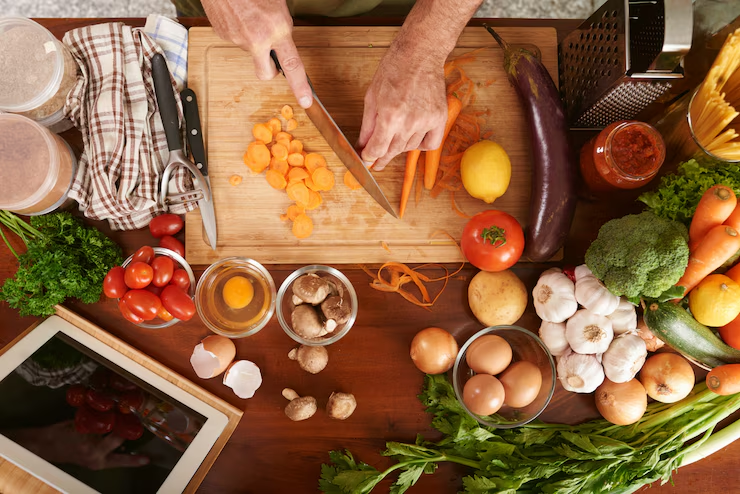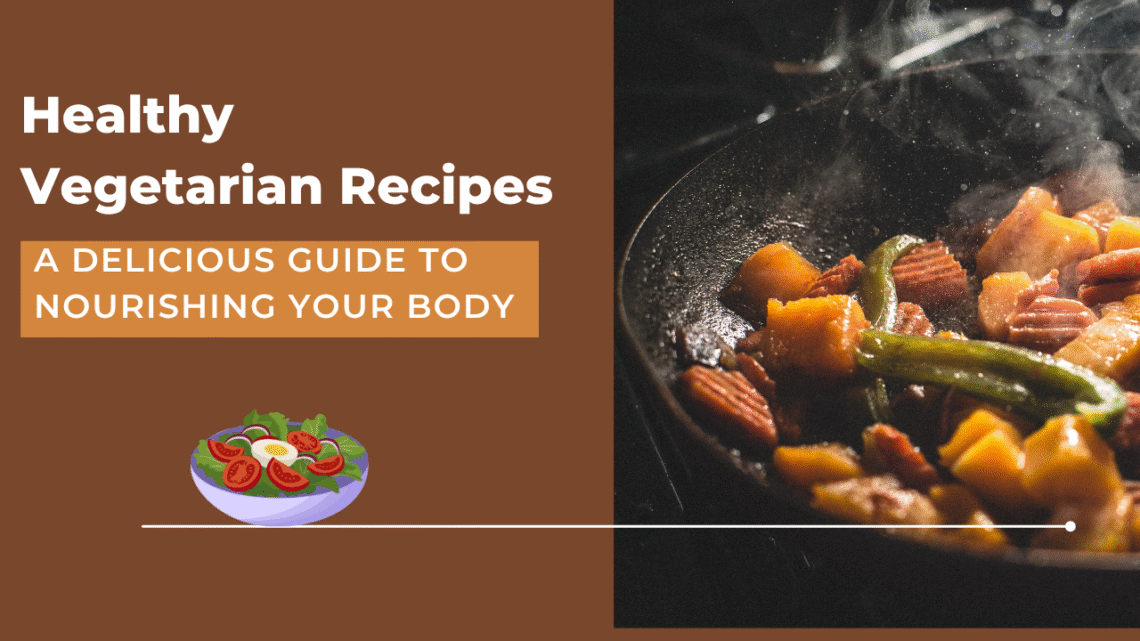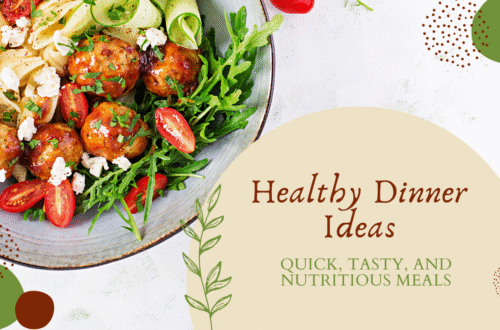In today’s fast-paced world, making time to eat well can be challenging. But the food choices we make have a profound impact on our physical health, energy levels, mental clarity, and overall well-being. Healthy recipes offer a gateway to achieving a balanced lifestyle without sacrificing taste. In fact, with the right ingredients and creative cooking techniques, eating healthy can be both satisfying and fun.
Discovering and mastering healthy recipes is a rewarding way to improve your overall well-being and enjoy delicious, nourishing meals every day. Whether you’re an experienced home chef or just beginning your journey toward better eating habits, learning how to prepare nutritious dishes can transform your health and lifestyle.
This comprehensive guide to healthy recipes explores everything you need to get started—from essential cooking techniques and smart ingredient choices to meal planning and preparation strategies. You’ll gain practical tips to make your kitchen more efficient and your meals more balanced, colorful, and satisfying.
Healthy recipes focus on using whole foods like lean proteins, fresh vegetables, whole grains, and healthy fats. They help reduce your intake of processed ingredients, excess sugar, and unhealthy fats, which are common culprits in many health issues today. The guide also features a variety of mouthwatering examples that prove eating well doesn’t mean sacrificing flavor.
No matter your skill level, this guide offers something valuable for everyone looking to embrace a healthier lifestyle through food. With the right approach and some creativity, healthy recipes can be simple, fun, and incredibly rewarding. Start cooking today and take the first step toward a healthier, happier you.
🥗 What Are Healthy Recipes?
Healthy recipes are thoughtfully created meals that prioritize nutrient-dense, whole-food ingredients to nourish the body while avoiding excess calories, sugar, unhealthy fats, and artificial additives. These recipes are designed to support overall health, boost energy, strengthen the immune system, and promote long-term wellness. Rather than relying on processed or refined foods, healthy recipes focus on natural, minimally processed ingredients that offer a rich supply of vitamins, minerals, antioxidants, and fiber.

Key elements of healthy recipes include whole grains like quinoa or brown rice, lean proteins such as fish, legumes, or tofu, healthy fats from sources like avocado and nuts, and a colorful variety of fresh fruits and vegetables. Herbs and spices are often used to enhance flavor naturally, reducing the need for excess salt or sugar.
By incorporating healthy recipes into your daily routine, you make a conscious choice to fuel your body with the nutrients it needs to function optimally. These meals not only taste great but also help maintain a healthy weight, improve digestion, regulate blood sugar, and support heart and brain health. Whether you’re cooking for yourself or your family, healthy recipes make it easy and enjoyable to eat well every day.:
- Whole grains
- Lean proteins
- Healthy fats
- Fresh fruits and vegetables
- Herbs and spices for flavor instead of excessive salt or sugar
Healthy cooking doesn’t mean boring food—it means food that fuels your body, boosts your immune system, and keeps chronic diseases at bay.
✅ Top 8 Tips for Creating and Enjoying Healthy Recipes
1. Focus on Whole Ingredients
Whole foods are the foundation of truly healthy recipes. These are foods that are either unprocessed or minimally processed, meaning they retain their original form and natural nutrients. Unlike heavily processed foods that often contain artificial ingredients, added sugars, unhealthy fats, and preservatives, whole foods are clean, simple, and packed with health-promoting benefits.
Examples of whole foods include fresh fruits and vegetables, whole grains like brown rice and oats, legumes, nuts, seeds, and lean proteins such as fish, chicken, or tofu. These ingredients are rich in vitamins, minerals, antioxidants, and fiber—all essential for maintaining energy, supporting digestion, and protecting against chronic disease.
When used in healthy recipes, whole foods not only contribute to better nutrition but also enhance the flavor and texture of meals. Cooking with whole foods allows you to take control of what goes into your body, helping you avoid hidden sugars, sodium, and unhealthy additives found in many pre-packaged meals.
Incorporating whole foods into your healthy recipes promotes a balanced diet and encourages a more mindful approach to eating. Whether you’re preparing a fresh salad, a hearty soup, or a grain bowl, starting with whole ingredients ensures every bite is as nutritious as it is delicious.
Examples include:
- Quinoa, oats, and brown rice (whole grains)
- Fresh fruits and vegetables
- Beans, legumes, nuts, and seeds
- Lean cuts of chicken, turkey, and fish
🌟 Tip: Swap white rice with quinoa or cauliflower rice. Replace white bread with 100% whole grain or sprouted grain bread.
2. Use Healthy Cooking Methods

How you cook your food can greatly influence how nutritious it remains. Healthy cooking methods include:
- Steaming
- Grilling
- Baking
- Roasting
- Sautéing with olive oil or avocado oil
🔥 Avoid: Deep-frying, over-boiling vegetables (which can destroy nutrients), and using hydrogenated oils.
🌟 Tip: Use an air fryer for crispy texture without excess oil.
3. Embrace Plant-Based Proteins
While animal protein is healthy in moderation, plant-based proteins are lower in saturated fat and rich in fiber. Include:
- Lentils
- Chickpeas
- Black beans
- Tofu
- Tempeh
- Edamame
🌱 Tip: Try “Meatless Mondays” to reduce meat intake and explore new recipes like lentil curry, chickpea salad, or grilled tofu bowls.
4. Cut Back on Sugar and Salt
One of the key principles of creating healthy recipes is reducing the use of excessive sugar and salt. High levels of added sugar and sodium are major contributors to serious health issues such as obesity, high blood pressure (hypertension), heart disease, and even type 2 diabetes. Unfortunately, most processed and packaged foods contain hidden amounts of both, which can sabotage even the most well-intentioned diet.
When preparing healthy recipes at home, you gain control over the ingredients you use. Instead of relying on salt or sugar to enhance flavor, turn to natural alternatives like fresh herbs, spices, citrus juices, garlic, and vinegar. These not only add depth and aroma to your meals but also provide additional health benefits—like antioxidants and anti-inflammatory compounds.
For example, use herbs like basil, rosemary, and thyme in sauces, or add turmeric and cumin to soups and stews. Fresh lemon juice or a splash of apple cider vinegar can brighten up roasted vegetables or salads without needing extra salt.
By avoiding processed flavorings and embracing natural seasonings, you make your healthy recipes both heart-friendly and flavorful. Over time, your taste buds will adjust, and you’ll begin to appreciate the real, wholesome taste of food without excess sugar or salt.
- Herbs (basil, thyme, rosemary)
- Spices (turmeric, paprika, cumin)
- Garlic, lemon juice, or vinegar
🌟 Tip: Make your own sauces and dressings at home using Greek yogurt, olive oil, and herbs.
5. Practice Portion Control

Even healthy meals can lead to weight gain if portion sizes are too large. Use smaller plates, and balance your meals with:
- ½ plate vegetables
- ¼ plate lean protein
- ¼ plate complex carbs
🥗 Tip: Eat slowly and stop when you’re 80% full. This gives your brain time to register fullness.
6. Plan Meals in Advance
One of the smartest habits for maintaining a nutritious lifestyle is meal planning, especially when it comes to incorporating healthy recipes into your daily routine. Planning your meals in advance not only helps you stay on track with your health goals but also significantly reduces food waste, saves money, and eliminates the temptation of reaching for unhealthy, last-minute options.
By setting aside time each week to create a meal plan filled with balanced, healthy recipes, you ensure your kitchen is stocked with the right ingredients. This allows you to make smarter grocery choices—shopping with a list based on your meal plan helps avoid impulse buys and cuts down on excess spending.
Prepping ingredients ahead of time—such as washing and chopping vegetables, cooking grains in batches, or marinating proteins—saves time during busy weekdays and makes it easier to stick to your plan. You’ll also be more likely to cook at home, which studies show leads to healthier eating patterns.
Whether you’re preparing for a busy week of work or ensuring your family eats well, meal planning built around healthy recipes is a practical strategy that leads to better nutrition, reduced stress, and greater consistency in making nourishing food choices.
🛒 Tip: Store chopped veggies in airtight containers. Cook grains and proteins in batches to simplify weeknight dinners.
7. Balance Macronutrients
A healthy recipe includes the right ratio of:
- Carbohydrates: For energy (whole grains, fruits)
- Proteins: For muscle and repair (beans, eggs, fish)
- Fats: For brain and hormone function (nuts, seeds, avocados)
🥑 Tip: Include all three macronutrients in each meal to stay full and energized longer.
8. Make It Colorful and Fun
Colorful plates usually indicate a variety of vitamins and minerals. Mix greens, reds, oranges, and purples using:
- Spinach, kale (green)
- Bell peppers, tomatoes (red)
- Carrots, sweet potatoes (orange)
- Beets, red cabbage (purple)
🎨 Tip: The more vibrant your plate, the more nourishing it tends to be. Challenge yourself to “eat the rainbow” each day.
🍽️ Benefits of Following Healthy Recipes
🧠 Improved Mental Clarity
Eating a balanced diet is essential for maintaining cognitive function, enhancing memory, and supporting overall brain health. Nutrients such as omega-3 fatty acids, antioxidants, and B vitamins play a crucial role in this process. Including these brain-boosting nutrients in your daily meals can improve mental clarity, focus, and even help protect against age-related cognitive decline.
Healthy recipes that feature ingredients like fatty fish (salmon, mackerel, sardines), walnuts, flaxseeds, leafy greens, berries, and whole grains are especially beneficial for brain health. Omega-3 fatty acids, found in fish and flaxseeds, support the structure of brain cells and enhance communication between neurons. Antioxidants, abundant in colorful fruits and vegetables like blueberries, spinach, and broccoli, help protect brain cells from oxidative stress. Meanwhile, B vitamins—found in eggs, legumes, and whole grains—aid in energy production and the regulation of neurotransmitters.
Creating healthy recipes with these nutrient-rich ingredients not only supports your physical health but also sharpens your mind. Try adding spinach to a morning smoothie, grilling salmon for dinner, or preparing a quinoa salad with walnuts and mixed greens. With thoughtful ingredient choices, your meals can be both delicious and mentally nourishing, helping you feel focused, energized, and sharp every day.
❤️ Better Heart Health

Maintaining heart health starts with the food you eat. One of the most effective ways to support cardiovascular wellness is by limiting saturated fats and salt while increasing your intake of dietary fiber. Saturated fats, commonly found in red meat, full-fat dairy, and processed snacks, can raise LDL (bad) cholesterol levels, leading to clogged arteries and increased risk of heart disease. Similarly, high sodium intake is linked to elevated blood pressure, which puts strain on the heart and blood vessels.
Healthy recipes offer a powerful solution by emphasizing clean, nutrient-rich ingredients that nourish the heart. Replacing saturated fats with healthier options—like olive oil, nuts, seeds, and avocados—can improve cholesterol profiles. Reducing salt and instead flavoring food with herbs, spices, lemon juice, or garlic can also help maintain healthy blood pressure levels without compromising taste.
Equally important is fiber, found in foods like oats, legumes, fruits, vegetables, and whole grains. Soluble fiber, in particular, helps lower LDL cholesterol and supports better digestion.
By preparing healthy recipes that focus on these principles, you can enjoy delicious, satisfying meals while actively protecting your heart. Over time, these small dietary changes can lead to significant, long-term health benefits and improved overall well-being.
🩺 Disease Prevention
Following a diet centered around healthy recipes can significantly reduce your risk of developing chronic health conditions such as diabetes, cancer, and autoimmune diseases. The foods we eat play a powerful role in either supporting or harming our body’s internal systems. When you consistently choose meals made from fresh, whole-food ingredients, you’re giving your body the tools it needs to defend itself and function optimally.
Healthy recipes are typically low in refined sugars, unhealthy fats, and processed ingredients—factors commonly linked to inflammation and insulin resistance, which are major contributors to type 2 diabetes and certain cancers. By focusing on nutrient-dense foods like leafy greens, colorful vegetables, whole grains, lean proteins, legumes, nuts, and seeds, you’re naturally reducing inflammation and promoting better blood sugar control.
Additionally, many healthy ingredients are packed with antioxidants and phytochemicals that protect cells from damage and support a stronger immune system. This can lower your risk of various cancers and help manage or even prevent autoimmune disorders.
Preparing healthy recipes at home gives you control over what you consume, allowing you to avoid hidden sugars, preservatives, and additives often found in packaged foods. Over time, this mindful approach to eating can transform your health and protect you from life-altering diseases
🌟 Increased Energy and Mood Stability
Eating nutritious meals is essential not only for physical health but also for emotional and mental well-being. Balanced, nutrient-rich foods help stabilize blood sugar levels and support hormonal balance, which are both key factors in maintaining a steady mood and sustained energy throughout the day. When your blood sugar fluctuates—often due to high-sugar or processed meals—it can lead to energy crashes, irritability, and difficulty concentrating.
Healthy recipes are crafted to provide a balanced combination of complex carbohydrates, healthy fats, and lean proteins. This combination slows the absorption of sugar into the bloodstream, helping to avoid energy spikes and crashes. Foods like whole grains, leafy greens, nuts, seeds, legumes, and lean proteins nourish the body while supporting hormone function, brain health, and emotional balance.
🧘 Weight Management
Healthy recipes are naturally lower in calories and higher in fiber, making them ideal for supporting weight management and overall wellness. The high fiber content found in vegetables, fruits, whole grains, and legumes helps you feel full longer, reducing the urge to overeat. By promoting better portion control and appetite regulation, healthy recipes make it easier to maintain a balanced diet without feeling deprived. Additionally, these meals are packed with essential nutrients that fuel your body efficiently. Incorporating healthy recipes into your daily routine is a simple yet effective way to stay satisfied, energized, and on track with your health goals.
🥘 Sample Healthy Recipes to Try Today
🥣 1. Overnight Oats with Berries
Ingredients:
- ½ cup rolled oats
- ½ cup unsweetened almond milk
- ½ banana (mashed)
- 1 tbsp chia seeds
- ½ cup mixed berries
- Drizzle of honey or maple syrup (optional)
Instructions:
- Mix oats, banana, chia seeds, and almond milk in a jar.
- Refrigerate overnight.
- Top with fresh berries before serving.
🌟 Benefits: High in fiber, omega-3s, and antioxidants.
🥗 2. Quinoa and Chickpea Salad
Ingredients:
- 1 cup cooked quinoa
- ½ cup canned chickpeas (rinsed)
- 1 diced cucumber
- ½ chopped red onion
- 10 cherry tomatoes, halved
- 2 tbsp olive oil
- Juice of 1 lemon
- Salt, pepper, parsley
Instructions:
- Toss all ingredients in a large bowl.
- Chill before serving.
🌟 Benefits: Complete protein, refreshing, and ideal for meal prep.
🥦 3. Stir-Fried Veggie Bowl with Brown Rice
Ingredients:
- 1 cup brown rice (cooked)
- ½ cup broccoli florets
- ½ bell pepper (sliced)
- ½ carrot (julienned)
- 1 tsp sesame oil
- 1 tbsp low-sodium soy sauce
- 1 tsp ginger, minced
Instructions:
- Stir-fry veggies in sesame oil for 5–7 mins.
- Add soy sauce and ginger.
- Serve over brown rice.
🌟 Benefits: High fiber, low-fat, rich in antioxidants.
🥑 4. Avocado Toast with Eggs
Ingredients:
- 2 slices whole-grain bread
- 1 ripe avocado
- 2 boiled or poached eggs
- Pinch of salt, pepper, chili flakes
Instructions:
- Mash avocado onto toasted bread.
- Top with eggs, season, and enjoy.
🌟 Benefits: Healthy fats, protein, and fiber.
🍲 5. Lentil Soup
Ingredients:
- 1 cup lentils
- 1 chopped onion
- 2 chopped carrots
- 2 cloves garlic
- 1 tbsp olive oil
- 4 cups vegetable broth
- Cumin, turmeric, pepper
Instructions:
- Sauté onion, garlic, and carrots in olive oil.
- Add broth, lentils, and spices.
- Simmer for 25–30 mins until lentils are soft.
🌟 Benefits: Great source of protein, iron, and fiber.
📚 Frequently Asked Questions About Healthy Recipes
1. Are healthy recipes expensive?

Healthy recipes don’t have to be expensive. In fact, many nutritious ingredients like beans, oats, eggs, lentils, and seasonal vegetables are highly affordable and widely available. By choosing whole, unprocessed foods and shopping smart, you can create balanced, delicious meals on a budget. Planning your meals ahead of time using healthy recipes not only ensures better nutrition but also reduces food waste and lowers grocery costs. Batch cooking and reusing ingredients across multiple meals can save both time and money. With the right approach, healthy eating becomes accessible, economical, and sustainable for individuals and families alike.
2. Can I eat healthy if I’m always busy?
Yes, even with a busy lifestyle, it’s easy to stick to healthy recipes. Opt for quick and simple options like smoothies, salads, and wraps that take just 10 minutes or less to prepare. Batch cooking is another smart strategy—cook large portions of healthy meals like soups, stir-fries, or grain bowls and store them for the week. You can also explore meal prep services that offer pre-portioned, nutritious ingredients to save time. With a little planning, healthy recipes can be both convenient and satisfying, helping you stay on track with your health goals even during the most hectic days.
3. What’s the difference between low-calorie and healthy?
Low-calorie isn’t always healthy. A food may be low in calories but lack essential nutrients. A healthy recipe focuses on nutrient density—not just cutting calories.
4. Can healthy food be tasty?
Absolutely! With the right blend of herbs, spices, and smart cooking methods, healthy recipes can be just as flavorful and satisfying as restaurant dishes—if not more. Using ingredients like garlic, ginger, cumin, turmeric, basil, or chili flakes can add depth and excitement to any meal without relying on excess salt or unhealthy fats. Grilling, roasting, and sautéing help enhance natural flavors while preserving nutrients. The key to delicious healthy recipes lies in creativity and freshness. By experimenting with seasonings and cooking techniques, you can enjoy meals that are both nourishing and full of bold, irresistible flavors every day.
📅 Weekly Healthy Recipe Plan (Sample)
| Day | Breakfast | Lunch | Dinner |
| Monday | Overnight oats | Quinoa salad | Stir-fried veggie bowl |
| Tuesday | Smoothie with spinach | Grilled chicken wrap | Lentil soup |
| Wednesday | Greek yogurt with berries | Chickpea curry | Baked salmon with sweet potato |
| Thursday | Avocado toast with eggs | Veggie wrap | Brown rice bowl with tofu |
| Friday | Chia pudding | Zucchini noodles w/pesto | Grilled shrimp + salad |
| Saturday | Whole wheat pancakes | Veggie grain bowl | Turkey stir-fry |
| Sunday | Scrambled eggs + spinach | Buddha bowl | Baked veggie casserole |
🌈 Conclusion: Healthy Recipes for a Healthy Life
Healthy recipes are more than just meals—they’re investments in your future. With a little planning and creativity, you can enjoy dishes that are good for your body and soul. Start small, use the top 8 tips outlined above, and build a repertoire of go-to meals that nourish and delight you.
Eating healthy doesn’t mean giving up on flavor—it means discovering new favorites that help you thrive every day. So head to your kitchen, grab your apron, and start your journey toward a healthier, happier you—one delicious recipe at a time.





